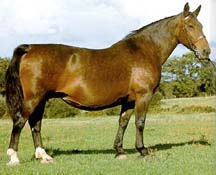Groningen
N/A
Tue, 26th November, 2024 - 9:39 pm GMT
Sponsor Ads:

Alternative Name
N/ABasic Info
Groningen horses have a long head with a straight face and long ears. The neck is of medium length and well muscled, wide at the base; the withers are prominent and long; the back is long; the croup is flat with a high tailset; and the quarters are powerfully muscled. The chest is wide and deep with great depth to the girth. The legs are short, well muscled, and strong with excellent joints and well-shaped hooves. The primary colors are black, bay or brown. The Groningen stands between 15.3 and 16.1 hands.
Health
N/AHabitat
N/ABehavior
Use : Riding, harness. Is a frugal, willing horse.Origin
Northeastern Netherlands provinceHistory
The Groningen breed originated in the northeastern Netherlands province of the same name. (see map)The breed resulted from the crossing of the East (Dutch) Friesian and German Oldenburg with native stock found in the province. In this region, the soil is of a heavy clay requiring a much heavier and denser horse than the lighter type horse developed for the sandy soil of central and eastern regions, the Gelderland. In the nineteenth century, the Suffolk Punch was crossed with the breeding stock to give the Groningen weight and strength. With the mechanization of agriculture, this heavy farm horse was bred with lighter breeds producing a heavyweight saddle horse and an excellent carriage horse. In the 1970s, the Groningen breed nearly became extinct when only one purebred stallion remained (other than its crossbred descendants in the Dutch Warmblood breed). Today, breeders have taken steps to assure preservation of this old breed. Like the Dutch Gelderland, the Groningen has today been aborbed for the most part into the Dutch Warmblood breed. The powerful quarters of the Groningen have contributed greatly to the jumping power of the Dutch Warmblood and the Groningen is designated a basic type in the Dutch Warmblood stud book.Common Foods
grassSponsor Ads:
"No cause, no God, no abstract idea can justify the mass slaughter of innocents." -- Edward Said
Groningen
Coded by: BGID® | ALL RIGHTS RESERVED Copyright © 2000-2024
Disclaimer | Privacy | Report Errors / Contact | Credits


 President of the United States of America - Real Estate mogul, Pageant owner and now one of the most controversial men in political history.
President of the United States of America - Real Estate mogul, Pageant owner and now one of the most controversial men in political history.  Politician, US Vice President and President of the USA - Joseph Robinette Biden Jr.
Politician, US Vice President and President of the USA - Joseph Robinette Biden Jr.  versus
versus  Russia: 'The Evil Empire'? Are they all that bad or is it just the USA trying to portray Russia as bad because they are a world power with land bigger and a society very different from the USA ideal?
Russia: 'The Evil Empire'? Are they all that bad or is it just the USA trying to portray Russia as bad because they are a world power with land bigger and a society very different from the USA ideal?  Global warming has been in and out as the "latest" hot topic for many years. It is, according to modern scientists, the result of man-made industrial pollutants, clearing forested areas, agriculture, etc. But now they are thinking it started way before the Industrial Revolution...
Global warming has been in and out as the "latest" hot topic for many years. It is, according to modern scientists, the result of man-made industrial pollutants, clearing forested areas, agriculture, etc. But now they are thinking it started way before the Industrial Revolution... 
 Corona virus
Corona virus 
 Users with wide screen monitors can benefit from more content on every page.
Users with wide screen monitors can benefit from more content on every page.